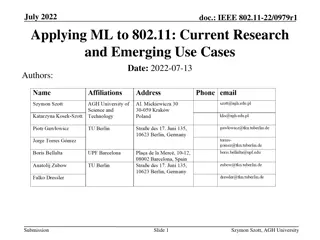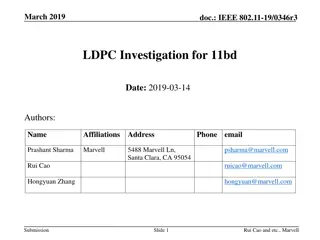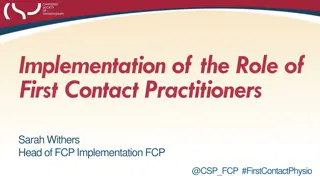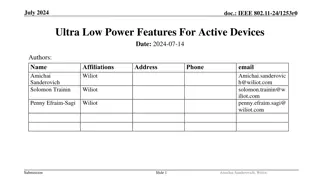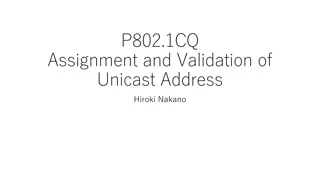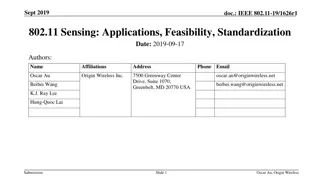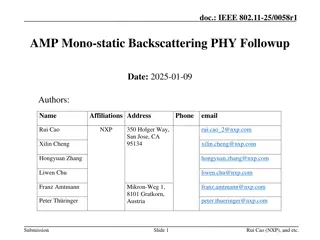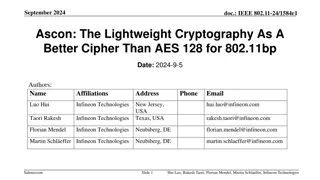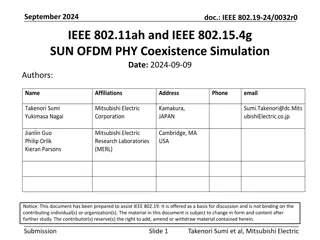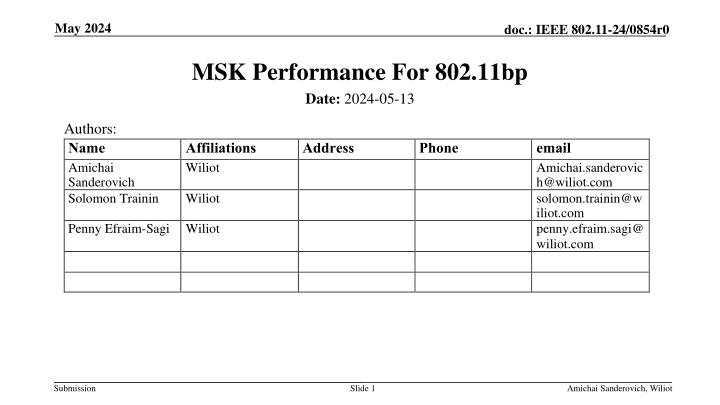
IEEE 802.11 Modulation: Advantages of MSK for Uplink Performance
In this presentation, the advantages of Minimum Shift Keying (MSK) for uplink modulation in the IEEE 802.11 amendment for active and backscatter transmitters are discussed. Comparisons between modulations for different devices and the historical applicability of MSK are highlighted. The spectral density and power/frequency characteristics for both backscatter and active transmitters are also presented for reference.
Download Presentation

Please find below an Image/Link to download the presentation.
The content on the website is provided AS IS for your information and personal use only. It may not be sold, licensed, or shared on other websites without obtaining consent from the author. If you encounter any issues during the download, it is possible that the publisher has removed the file from their server.
You are allowed to download the files provided on this website for personal or commercial use, subject to the condition that they are used lawfully. All files are the property of their respective owners.
The content on the website is provided AS IS for your information and personal use only. It may not be sold, licensed, or shared on other websites without obtaining consent from the author.
E N D
Presentation Transcript
May 2024 doc.: IEEE 802.11-24/0854r0 MSK Performance For 802.11bp Date: 2024-05-13 Authors: Name Amichai Sanderovich Solomon Trainin Affiliations Wiliot Address Phone email Amichai.sanderovic h@wiliot.com solomon.trainin@w iliot.com penny.efraim.sagi@ wiliot.com Wiliot Penny Efraim-Sagi Wiliot Submission Slide 1 Amichai Sanderovich, Wiliot
May 2024 doc.: IEEE 802.11-24/0854r0 Abstract As modulation is one of the first decisions the 802.11bp PHY/MAC amendment is required to make, in this presentation, we discuss the advantages of MSK for uplink modulation for 802.11bp amendment for both active and backscatter transmitters. Submission Slide 2 Amichai Sanderovich, Wiliot
May 2024 doc.: IEEE 802.11-24/0854r0 Recap In [1], we presented a comparison between possible modulations for AMP active devices (non-backscatter), as well as considered backscattered based. According to analysis, BPSK and OFDM are no-go for energy harvesting active devices such as 802.11bp. The power consumption and summary tables from [1] are given here for reference: Examplary total AFE power consumption 100uW 100uW 500uW 1.5mW OOK MSK/BFSK /4-FSK Good Good BPSK OFDM TX complexity Energy consumption Good Poor [due to SNR] Poor Fair Poor Poor Poor OOK MSK/BFSK/4-FSK BPSK OFDM Link budget Good Good Good Submission Slide 3 Amichai Sanderovich, Wiliot
May 2024 doc.: IEEE 802.11-24/0854r0 MSK Applicability Nothing new: MSK is historically used by many standards for very long time. Extensive long products and standard history and knowledge availability Besides OFDM systems that traditionally have higher quality hardware, most low power standards do not implement BPSK and use MSK or FSK due to its simplicity. MSK for backscatter already reported (e.g. for BT [2]) as well. Submission Slide 4 Amichai Sanderovich, Wiliot
May 2024 doc.: IEEE 802.11-24/0854r0 Spectrum Comparison Spectral density for backscatter transmitter with data rate=9Mbps -65 MSK (Backscatter) PR-PSK w. Miller M=2 (Backscatter) SSB/DSB Simple active devices (with no more than 1 chain) can have SSB modulation for MSK,PSK,OOK SSB is favorable in terms of spectrum efficiency and interference. Backscatter devices usually implement DSB modulations for MSK,OOK,PSK, due to their simplicity and for distancing from CW. No pulse shaping is assumed, due to the simplicity of devices, nonlinearity of PA, etc. -70 Power/frequency (dB/Hz) 10dB -75 -80 -85 -90 -95 CW -100 -20 -10 0 10 Frequency (MHz) 20 30 40 50 60 Spectral density for active transmitter with data rate=9Mbps MSK(Active) BPSK (Active) -70 Power/frequency (dB/Hz) -80 -90 Continues phase vs discontinues-phase Continues phase signals like MSK have lower out-of-band emissions compared to non-continues phase like BPSK or OOK (w.o. pulse shaping). 10-15dB differences were noticed 15dB -100 -110 -120 -60 -40 -20 0 20 40 60 Frequency (MHz) Submission Slide 5 Amichai Sanderovich, Wiliot
May 2024 doc.: IEEE 802.11-24/0854r0 Issues To Consider for Spectrum Comparison It is important to allow spectrally efficient transmissions for 802.11bp devices Longer distances compared to RFID but with same density of devices results with more devices per reader. FDM should be considered for the expected amount of devices ([3]) Energizing signals are broadcasted, so uplink is the bottleneck and FDM can be useful. Minimal interference to/from legacy devices Eventhough the AIoT devices transmit with very low power, we still should aim to minimize interference for the busy 2.4 channel. Submission Slide 6 Amichai Sanderovich, Wiliot
May 2024 doc.: IEEE 802.11-24/0854r0 MSK Transmitter Examplery Implementations in Active and Backscatter Devices Both active and backscatter MSK transmissions require 2 oscillators. One for the modulation and one for the symbol clock. For the example from previous slide, the following values should be used in the schemes below: Fc = 2414.2/2409.8MHz, Fs=9MHz, Fm=11.25/6.75MHz Our analysis shows <0.5% difference in power consumption and complexity between MSK to OOK-Miller2 transmitters for backscatter and active devices for the example Submission Slide 7 Amichai Sanderovich, Wiliot
May 2024 doc.: IEEE 802.11-24/0854r0 Performance Simulation Performance of uncoded MSK/BPSK/OOK are presented below AWGN Optimal coherent reception of the uplink signal is used Noncoherent reception reduces the performance MSK allows the use of efficient coherent demodulation MSK and BPSK have the same performance As expected, OOK is 3dB worse compared to both MSK/BPSK due to non-antipodal signaling OOK relies on energy levels and is thus sensitive to gain instabilities and interference Practical perfromance degradation vs MSK is more than 3dB BLER for 96 bits payload 100 MSK coherent receiver BPSK OOK 10-1 BLER = 10% BLER 10-2 BLER = 1% 10-3 4 5 6 7 8 SNR [dB] 9 10 11 12 13 Submission Slide 8 Amichai Sanderovich, Wiliot
May 2024 doc.: IEEE 802.11-24/0854r0 Summary Backscatter <0.5% difference between MSK/PSK/OOK 10dB advantage to MSK over OOK/BPSK w. Miller >3dB degradation of OOK compared to MSK/BPSK Active Only MSK and OOK are within limits 15 dB advantage to MSK over BPSK/OOK >3dB degradation of OOK compared to MSK/BPSK TX Complexity + Power consumption OOB emissions for FDM feasability and legacy interference Performance Should 802.11bp consider devices that can transmit MSK modulation to the AMP-reader? Submission Slide 9 Amichai Sanderovich, Wiliot
May 2024 doc.: IEEE 802.11-24/0854r0 References [1] Uplink Modulations Comparison for AMP Devices , Wiliot, 0112r0 [2] Harms O. Modulation schemes in ambient backscatter communication [Dissertation]. 2017. (IT), Uppsala University, Mathematics and Computer Science, Department of Information Technology. [3] "Uplink FDM for AMP , OPPO, 0851r0 Submission Slide 10 Amichai Sanderovich, Wiliot


